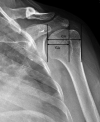MRI is a Reliable Method for Measurement of Critical Shoulder Angle and Acromial Index
- PMID: 37908539
- PMCID: PMC10615611
- DOI: 10.1055/s-0043-1776136
MRI is a Reliable Method for Measurement of Critical Shoulder Angle and Acromial Index
Abstract
Objective The objectives of this study are to compare absolute values of acromial index (AI) and critical shoulder angle (CSA) obtained in both radiographs and magnetic resonance image (MRI) of the shoulder; and to compare the interobserver and intra-observer agreement for AI and CSA values measured in these image modalities. Methods Patients who had medical indication of investigating shoulders conditions through radiographs and MRI were included. Images were taken to two fellowship-trained shoulder surgeons, which conducted measurements of AI and CSA in radiographs and in MRI. Twelve weeks after the first evaluation, a second evaluation was conducted. Inter- and intra-observer reliability was presented as an Intraclass Correlation Coefficient (ICC) and agreement was classified according to Landis & Koch criteria. The differences between two measurements were evaluated using Bland-Altman plots. Results 134 shoulders in 124 subjects were included. Mean intra-observer ICC for CSA in X-rays and in MRI were 0.936 and 0.940, respectively; for AI, 0.908 and 0.022. Mean inter-observer ICC for CSA were 0.892 and 0.752 in X-rays and MRI respectively; for AI, ICC values were 0.849 and 0.685. All individual analysis reached statistical power ( p < 0.001). Mean difference for AI values measured in X-rays and in MRI was 0.01 and 0.03 for observers 1 and 2, respectively. Mean difference for CSA values obtained in X-rays and MRI was 0.16 and 0.58 for observers 1 and 2, respectively. Conclusion Both MRI and X-rays provided high intra- and interobserver agreement for measurement of AI and CSA. Absolute values found for AI and CSA were highly correlated in both image modalities. These findings suggest that MRI is a suitable method to measure AI and CSA. Level of Evidence II , Diagnostic Study.
Keywords: acromion; magnetic resonance imaging; radiography; rotator cuff tear; shoulder impingement syndrome.
Sociedade Brasileira de Ortopedia e Traumatologia. This is an open access article published by Thieme under the terms of the Creative Commons Attribution-NonDerivative-NonCommercial License, permitting copying and reproduction so long as the original work is given appropriate credit. Contents may not be used for commercial purposes, or adapted, remixed, transformed or built upon. ( https://creativecommons.org/licenses/by-nc-nd/4.0/ ).
Conflict of interest statement
Conflito de Interesses Os autores não têm conflitos de interesses a declarar.
Figures








References
-
- Maffulli N, Longo U G, Berton A, Loppini M, Denaro V. Biological factors in the pathogenesis of rotator cuff tears. Sports Med Arthrosc Rev. 2011;19(03):194–201. - PubMed
-
- Sayampanathan A A, Andrew T HC. Systematic review on risk factors of rotator cuff tears. J Orthop Surg (Hong Kong) 2017;25(01):2.309499016684318E15. - PubMed
-
- Morikawa D, Itoigawa Y, Nojiri H et al.Contribution of oxidative stress to the degeneration of rotator cuff entheses. J Shoulder Elbow Surg. 2014;23(05):628–635. - PubMed
-
- Figueiredo E A, Loyola L C, Belangero P S et al.Rotator cuff tear susceptibility is associated with variants in genes involved in tendon extracellular matrix homeostasis. J Orthop Res. 2020;38(01):192–201. - PubMed
LinkOut - more resources
Full Text Sources

